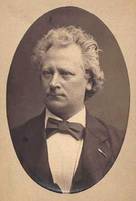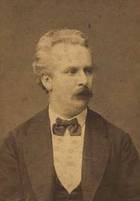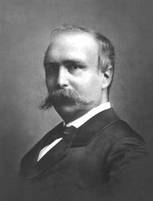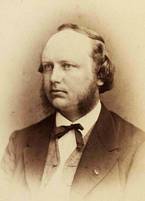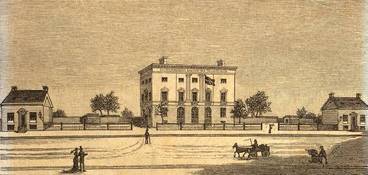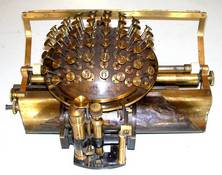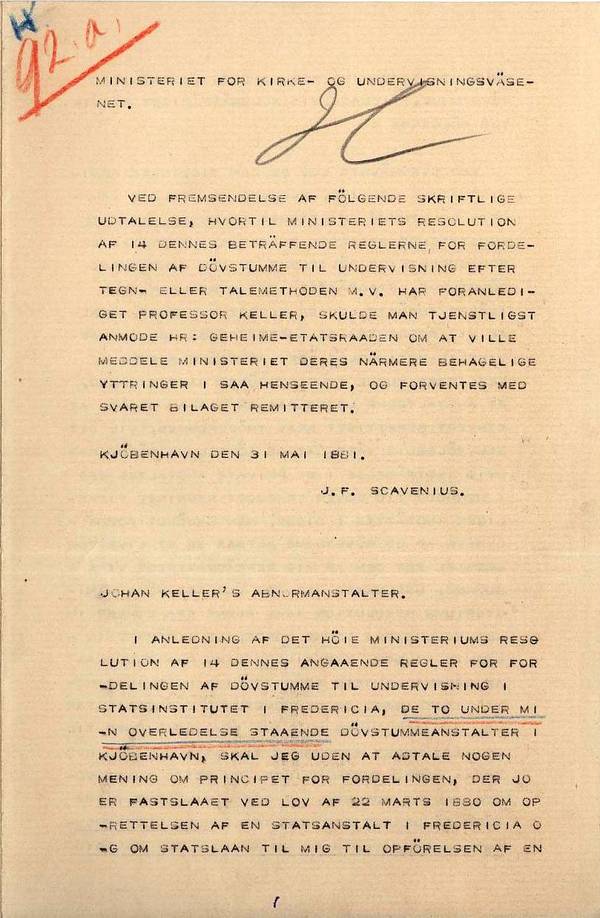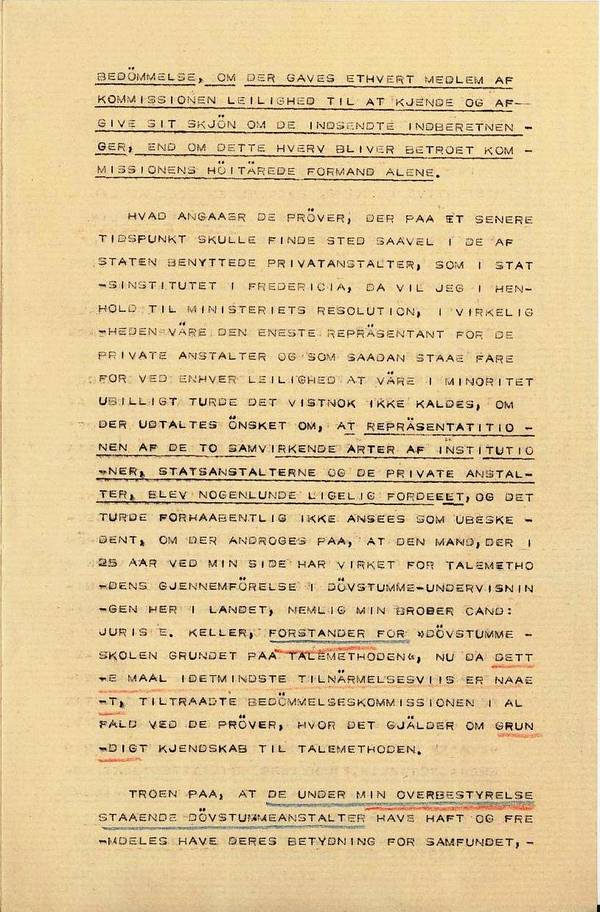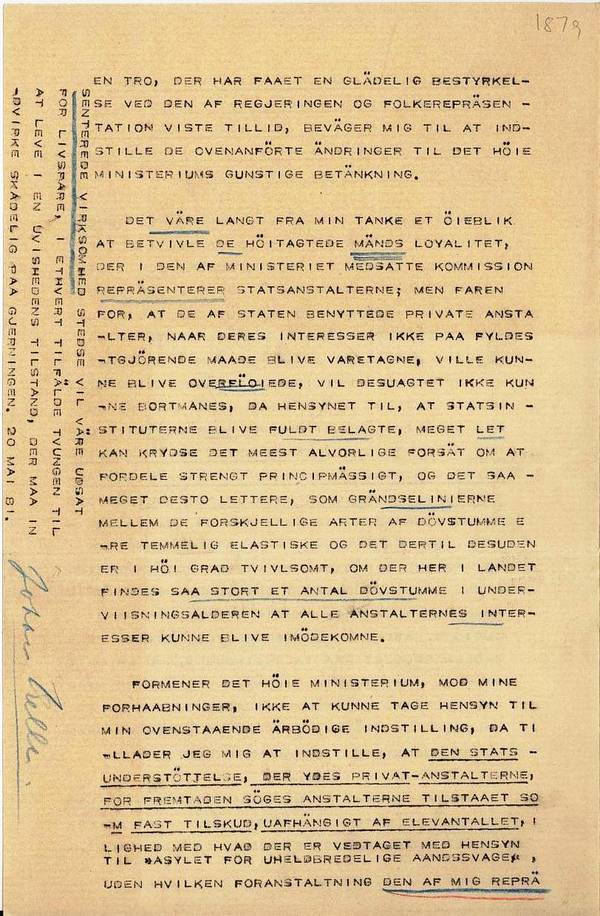1881.05.31 English
Comments to this ‘writing ball letter’ by Christian Barnholdt:
This document is ‘confusing’. It consists of two parts: A long letter from Johan Keller, dated 20th of May 1881, and a short ‘preface’ from J.F.Scavenius, dated 31st of May 1881.
Johan Keller (1830 - 84) was director of the so called ‘Keller Institutions for the mentally deficient’, and had as crucial a role for the mentally deficient as RMH had for the deaf-mute: An excellent reformer, educationalist and activist who fought the cause of the handicapped just like RMH did – and suffered a similar fate: to die in the height of his career and deed, far too young.
In connection with the letter 18790512UK, Sverre Avnskog provides a full account of the cooperation as well as the conflicts between Keller and Malling-Hansen.
J.F.Scavenius was at the time Minister of Culture and, as such, also the supreme authority for the education of the deaf-mute and the mentally challenged since – according to the Salmonsen Encyclopedia – the Ministry of Culture during the period 1848 until 1916 was the unofficial designation for ‘Ecclesiastical and educational affairs’.
It is rather weird to find ‘two letters in one’ and even more odd that all four pages were typed on the writing ball and with an extremely high typing quality. Please refer to the reproductions of the four pages. There are NO typing errors and the margins as well as the word divisions are very exact and sharp.
Hence, my conjecture is that these two (?) letters were originally written by hand – as was the custom at the time (except for RMH) – and that they were subsequently and for reasons unknown to us typed on the writing ball by RMH. I don’t believe that Johan Keller – and in particular not Minister Scavenius – had a writing ball or knew how to use it – and this, I believe, was also the case of their clerical staff.
As far as I know, letters and other documents were written by hand in Danish ministries until at least 1915. Who might know more about this?
The two letters are reproduced below:
THE MINISTRY FOR ECCLESIASTICAL AND EDUCATIONAL MATTERS[1]
BY SENDING THE ENCLOSED WRITTEN STATEMENT, PRESENTED BY PROFESSOR KELLER IN REPLY TO THE MINISTERIAL RESOLUTION OF THE 14TH THIS MONTH CONCERNING THE REGULATIONS FOR THE SELECTION OF DEAF-MUTE TO BE EDUCATED IN ACCORDANCE WITH THE SIGN- AND THE SPEECH-METHOD ETC, THE PRIVY COUNCILLOR IS RESPECTFULLY REQUESTED TO CONVEY HIS COMMENTS ON THE ISSUE AND TO RETURN SUCH COMMENTS TOGETHER WITH THE ENCLOSURE.[2]
COPENHAGEN MAY 31 1881
J.F.SCAVENIUS
JOHAN KELLER’S INSTITUTIONS FOR THE MENTALLY DEFICIENT[3]
IN CONNECTION WITH THE MINISTRY RESOLUTION DATED THE14TH OF THIS MONTH CONCERNING REGULATIONS FOR THE SELECTION AND DISTRIBUTION OF DEAF-MUTE FOR EDUCATION AT THE INSTITUTE AT FREDERICIA , RESPECTIVELY THE TWO INSTITUTIONS FOR THE DEAF-MUTE IN COPENHAGEN[4] I HUMBLY BEG TO COMMENT AS FOLLOWS, AVOIDING ANY VIEWS CONCERNING THE PRINCIPLE OF THE SELECTION, WHICH HAS ALREADY BEEN ESTABLISHED BY LAW OF MARCH 22 1880 ABOUT THE ESTABLISHMENT OF A PUBLIC INSTITUTION IN FREDERICIA AS WELL AS CONCERNING A GOVERNMENT LOAN TO ME FOR THE PURPOSE OF ERECTING A NEW INSTITUTION BUILDING FOR THE NOT COMPLETELY DEAF-MUTE PUPILS:
THE ABOVE MENTIONED LAW HAS AFFIRMED THE PREVIOUS ADMINISTRATIVE ARRANGEMENT WHEREBY A PORTION OF THE DEAF-MUTE OF THIS COUNTRY ARE TO BE ENTRUSTED THE EDUCATIONAL INSTITUTIONS FOR THE NOT COMPLETELY DEAF-MUTE AND MENTALLY DEFICIENT DEAF-MUTE UNDER MY DIRECTORSHIP. THE GOVERNMENT LOAN PROVIDED IN ACCORDANCE WITH THE ABOVE LAW IS DUE MY SERVICE OF INTEREST AND SINKING FUND; HOWEVER, AN IMPERATIVE PRE-CONDITION FOR THIS REQUIREMENT TO BE SATISFIED – AND, SIMULTANEOUSLY, THAT THE INSTITUTIONS ARE LED IN SUCH A WAY THAT EACH AND EVERY REASONABLE DEMAND IS MET – WILL EVIDENTLY BE THAT THOSE DEAF-MUTE CHILDREN, WHOSE ADMITTANCE INTO THE PRIVATE INSTITUTIONS HAS BEEN PLANNED AND CATERED FOR BY THE LAW, ARE IN FACT PLACED IN THESE INSTITUTIONS. HOWEVER, IN SPITE OF THE FACT THAT THE SELECTION AND PLACEMENT OF THE DEAF-MUTE IS, HENCE, A VITAL ISSUE FOR THE ESTABLISHMENT THAT I REPRESENT, BY MEANS OF THE DECISION TAKEN BY THE MINISTRY NOT ONLY AM I EXCLUDED FROM HAVING AN INFLUENCE ON THE SELECTION AND DISTRIBUTION AT ITS INITIAL STAGE: THE ONE THAT TAKES PLACE ON THE BASIS OF THE VARIOUS REPORTS FROM ALL PARTS OF THE COUNTRY, INFORMING ON THE CONDITION OF THE DEAF-MUTE CHILDREN, BUT WHAT IS MORE, I AM NOT EVEN PROVIDED THE OPPORTUNITY TO KNOW ABOUT THE BASIS ON WHICH THE SELECTION AND DISTRIBUTION IS MADE. ON THIS ASPECT I AM BOLD ENOUGH TO POSIT THAT WITHOUT DOUBT IT WOULD APPEAR LOGICAL - AND AT ANY RATE REASSURING FOR THE OBTAINMENT OF A BALANCED AND COMPREHENSIVE ASSESSMENT – IF EACH AND EVERY MEMBER OF THE COMMISSION BE PROVIDED THE OPPORTUNITY TO GATHER INFORMATION AND TO GIVE HIS VIEW ON THE VARIOUS REPORTS THAN IF THIS TASK IS ENTRUSTED SOLELY TO THE HONOURABLE CHAIRMAN OF THE COMMISSION.
CONCERNING THE EXAMINATIONS, DUE TO TAKE PLACE AT A LATER STAGE AT THE PRIVATE INSTITUTIONS USED BY THE GOVERNMENT, AS WELL AS AT THE GOVERNMENT INSTITUTION IN FREDERICIA, ACCORDING TO THE MINISTERIAL DECISION, IN REALITY I WILL BE THE ONLY REPRESENTATIVE OF THE PRIVATE INSTITUTIONS AND, AS SUCH, AT EACH OPPORTUNITY I WILL BE AT RISK OF BEING IN THE MINORITY. IT COULD HARDLY BE CONSIDERED UNREASONABLE IF WE EXPRESS THE WISH TO SEE A MORE EQUAL REPRESENTATION BY THE TWO CO-OPERATING PARTNERS, REPRESENTING PUBLIC AND PRIVATE INSTITUTIONS. LIKEWISE, IT SHOULD NOT BE SEEN AS IMMODERATE TO ARGUE THAT THE PERSON WHO FOR 25 YEARS HAS WORKED BY MY SIDE FOR THE INTRODUCTION OF THE SPEECH METHOD IN THE EDUCATION OF THE DEAF-MUTE IN THIS COUNTRY, MY BROTHER, BACHELOR OF LAWS E KELLER, PRINCIPAL OF THE “INSTITUTION FOR THE DEAF-MUTE, BASED ON THE SPEECH-METHOD”, NOW THAT WE ARE AT LEAST THIS CLOSE TO THE GOAL, SHOULD BE PERMITTED TO ASSIST THE ASSESSMENT COMMISSION, AT LEAST AT THE EXAMINATIONS WHERE A THOROUGH KNOWLEDGE OF THE SPEECH-METHOD IS CALLED FOR.
THE BELIEF THAT THE INSTITUTIONS FOR THE DEAF-MUTE UNDER MY DIRECTORSHIP HAVE BEEN OF IMPORTANCE TO SOCIETY, - A BELIEF GRATIFYINGLY CONFIRMED BY THE CONFIDENCE SHOWN BY THE GOVERNMENT AND BY THE PUBLIC REPRESENTATIVES – MOVES ME TO RESPECTFULLY PRESENT THE ABOVE AMENDMENTS TO THE MINISTERIAL REPORT.
I DO NOT FOR A MOMENT DOUBT THE LOYALTY OF THE HONOURED MEN REPRESENTING THE PUBLIC INSTITUTIONS IN THE MINISTERIAL COMMISSION; HOWEVER, THE DANGER THAT THE PRIVATE INSTITUTIONS USED BY THE GOVERNMENT MIGHT BE DISREGARDED IF THEIR INTERESTS ARE NOT FULLY CATERED FOR CANNOT BE CONJURED AWAY, SINCE THE CONSIDERATION TO FULLY OCCUPY THE PUBLIC INSTITUTIONS MAY VERY EASILY THWART EVEN THE MOST SERIOUS INTENT TO DISTRIBUTE STRICTLY ACCORDING TO ESTABLISHED PRINCIPLES, THIS DANGER MADE MORE PRONOUNCED BY FACT THAT THE DIVIDING BORDERS BETWEEN THE VARIOUS KINDS OF DEAF-MUTE ARE FAIRLY ELASTIC, IN ADDITION TO THE FACT THAT IT IS HIGHLY DOUBTFUL WHETHER THE COUNTRY HAS SUCH A LARGE NUMBER OF DEAF-MUTE AT THE SCHOOL INSTRUCTION AGE AS TO ACCOMMODATE THE INTERESTS OF ALL INSTITUTIONS.
SHOULD THE MINISTRY, AGAINST MY HOPES, CHOSE NOT TO TAKE MY ABOVE RESPECTFUL REQUESTS INTO CONSIDERATION, I WILL TAKE THE LIBERTY TO REQUEST THAT THE GOVERNMENT SUBSIDY GRANTED TO THE PRIVATE INSTITUTIONS IN FUTURE BE GRANTED AS A FIX SUBSIDY, IRRESPECTIVE OF THE NUMBER OF STUDENTS, IN PARITY WITH THAT WHICH HAS ALREADY BEEN DECIDED IN RESPECT OF THE “ASYLUM FOR THE INCURABLY MENTAL DEFICIENT”, WITHOUT WHICH PROVISION THE ACTIVITY THAT I REPRESENT[5] WILL FOREVER BE EXPOSED TO MORTAL DANGER OR, AT ANY RATE, BE FORCED TO EXIST IN A STATE OF UNCERTAINTY CLEARLY DETRIMENTAL TO OUR CAUSE. May 20,1881.
Johan Keller
(the letter has been signed “Johan Keller”, but not in his writing. The writer has used a blue pencil, such as the one RMH used, and it appears to be the handwriting of RMH)
[1] CB: As far as I understand the letter, this ‘document’ was sent by the Ministry for Ecclesiastical and Educational Affairs, originally by Minister Scavenius himself. Hence, we must assume that the original letter was written on official paper with the ministerial letterhead. To whom was the letter addressed? Probably to the Privy Councillor (in Danish: ‘Geheime-Etatsraad’). But who was he? No doubt a title indicating very high rank. Could it be someone even higher in the hierarchy than Mr Scavenius? Could it be the Prime Minister? Or the Secretary of State of the Prime Minister’s Office? I have researched on Google and in Danish Encyclopedias without finding any clue. However, we must conclude that Scavenius is sending the proposal/request/complaint from Keller to a higher level.
SA: I have also been trying to figure out how to comprehend this letter. Addressed to whom and from whom? In the beginning of the first part, which is signed “Scavenius”, we see that the “Privy Councillor” is requested to make a comment to the statements presented by Johan Keller in his letter. In my view it is very likely that this “Privy Councillor” is the director of the Institute for the Deaf-Mute, J.P.Trap, who in fact had this title. This would also explain how the “double letter” had come into Malling-Hansen’s hands and were typed on the writing ball. This is because RMH and Trap had developed a working relationship whereby RMH would open all mail, including items addressed to the Director, and decide which of the documents and issues that he needed to inform the Director about, and which issues he could take care of himself. Quite likely, the procedure concerning this letter has been that Johan Keller has written this letter to Minister Scavenius, who in his turn has forwarded the letter to Trap, requesting a comment. Hence, RMH has received the letter on behalf of the Director and has typed everything on the writing ball, intending either to pass it on or to produce a draft reply, which Trap has probably signed, following their usual working procedures.
[2] CB: The language is extremely bureaucratic, verging on the unintelligible! But in plain English: “The Ministry has on January 14 published a decision about how to decide where the deaf-mute pupils are to be taught (CB: in the various specialized institutions) in accordance with the sign method, respectively the speech-method (CB: Malling-Hansen and Keller arguing each their method). This is why professor Keller has sent us this letter, and we would like to hear your opinion about his views”.
[3] JMC: The original term is “institutions for the abnormal”. I have taken the liberty to use a more modern term.
[4] SA: When Keller suddenly passed away in 1884 he left behind a total of five so called “institutions for the abnormal” – and two of these institutions were for the education of deaf-mute children. According to the regulation of 1867 concerning the distribution of deaf-mute children between the privately run Keller Institutions and the publicly run Royal Institute for the Deaf-Mute, the “imbecile” and those not totally deaf-mute were to be taught at the Keller Institutions using the sign-method and the speech-method, respectively, while the actually deaf-mute were to be taught at the Royal Institute for the Deaf-Mute. In other words, Keller had one school for deaf-mute children who were also mentally deficient, to use a modern term, and one school for children who had – or had previously had – some degree of hearing ability and who were also able to speak. In other words, there were a total of three schools for the deaf in Copenhagen – two private ones under the leadership of Keller and one public school under the leadership of RMH.
The fact that RMH kept using the sign method at the Royal Institute, however, should not be interpreted to mean that he was in any way opposed to the more modern speech-method. In this field RMH was a pragmatist, realizing that there were advantages with the old as well as the new method. He himself mastered both, and already in 1872 the participants of the special education meeting in Copenhagen had the opportunity to observe RMH examine his graduating class which he had taught almost exclusively by means of the speech-method. For RMH the important point was to find the method that produced the best result for each individual pupil, and he was by no means a “fanatical” proponent of one or the other method. In 1880 RMH presented a bill about the establishment of a public institution where pupils were to be taught according to the speech-method. He was of the opinion that the new public institution should be established outside Copenhagen, the reason being that the deaf-mute would often socialize among themselves, and he was worried that the young students who were taught according to the speech-method would be influenced by the elder deaf-mute students who communicated by means of sign language, thus affecting the education negatively.
[5] CB: The last three lines of this ‘writing ball letter’ have been typed in the left hand margin and vertically! This appears very puzzling, but Sverre is of the opinion that the explanation is that RMH was using the very latest model of the writing ball – the version from 1884?
SA: So far, we have been under the assumption that the mechanic August Lyngbye did not take over the production of the writing ball until late in the 1880s, but a closer examination of RMHs letters shows that already by 1879 he received the first writing ball model , featuring Lyngbye’s low and broad-based version, issued with ribbon and platen. In a letter from 1879 RMH tells us about such a version, though without mentioning Lyngbye’s name – but judging from what he is describing, it can only be the Lyngbye model. The implication is that it was the Lyngbye model that was produced throughout the 1880s and until the death of RMh in 1890. According to the Lyngbye’s widow, at the time of his death RMH had an order for the production of 100 such writing balls – but the order was then cancelled. Whether Lyngbye continued to make writing balls after the demise of RMH we do not know, but it is not impossible.
The comment in the letter from 1879 is as follows:
COPENHAGEN 30TH OF NOVEMBER 1879
MY DEAR BROTHER !
WHAT YOU SEE HERE IS THE WRITING OF A BRAND NEW WRITING BALL, THAT ONLY HAS THE BALL AND THE TIPPING PART IN COMMON WITH THE OTHER MACHINES PRESENTLY BEING PRODUCED BY MY MECHANIC. THE WRITING BALL IS NOW TWO AND A HALF INCHES LOWER THAN BEFORE AND ONLY TWO INCHES BROADER. HOWEVER CAPABLE OF WRITING ON FOLIO SHEETS. – THIS MACHINE IS THE SECOND ONE OF THIS MODEL, IT IS SO SUCCESSFUL THAT WE CAN NOW MAKE A SERIAL PRODUCTION ON THE BASIS OF IT.

